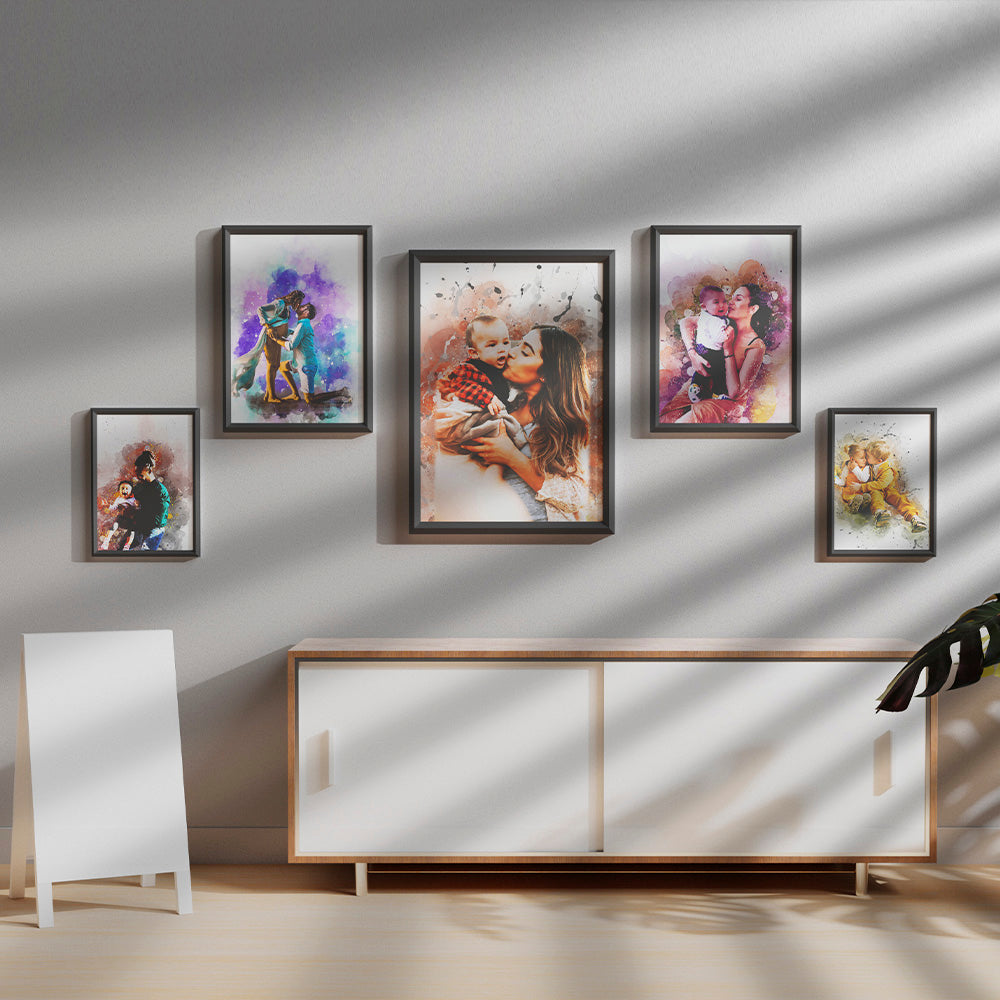Creating a wall of art is a wonderful way to enhance your space, showcase beautiful pieces and tie an interior design together. It allows you to evoke emotions in a room while also showing off your tastes and interests.
However, arranging artworks on a blank wall can be daunting.
That’s why we created this guide. Below, we show you, step by step, how to arrange wall art in different ways to maximize your wall space, including specific tips for designing a gallery wall.
With these pointers, you can deploy your art to have the greatest impact in your space, personalizing it in the most beautiful way.
1. Choose Your Wall

First, decide where you want to hang your artworks. Should you go for the obvious large wall or smaller spaces?
Large walls need to be filled. Small pieces on an expansive surface can look lost and isolated, so don’t be afraid to go big with one sizable work. Another good option is to create a grouping of pieces, and a spacious wall allows you to spread them out.
Smaller areas, like those between windows and doors, are the perfect places to display your more petite pieces. These can also be deployed in a cluster as a gallery wall.
2. Hang Art at Eye Level
A good rule is to hang an artwork so that its centre is at eye level, for easy viewing. Eye level, on average, is 57 to 60 inches off the ground.
You may want to hang your works lower if the room has a low ceiling, or in a living room, because its occupants are often sitting, so their eye level isn’t as high.
3. Consider the Furniture
Art can add interest to a sofa, console table, sideboard or bed. So, what should you consider when hanging artworks above furniture?
Generally, an art arrangement should usually be no wider than the piece of furniture it hangs over. In the case of a sofa, it should span an area two-thirds the width of the piece and start roughly 8 to 10 inches above it.
There are also practical considerations.
“I recommend leaving enough space above the piece of furniture to allow for usable workspace and to protect the art from other items damaging it,” says Susana Simonpietri, of Brooklyn home design studio Chango & Co. “For example, if the art is to hang above a bench or a sofa, I think about the head height of the client when seated. When arranging above a console or dining buffet, I think about space for flowers or even food. When placing art above an area that will likely have hot items underneath and around it, I’ll consider the steam and how it might affect the piece over time.”

Tips for Arranging Wall Art
When deciding how to arrange art on a wall, there are many factors to consider: the surface, the spacing and the tools needed, to name a few. Below, we provide pointers to help you decide on the right layout, achieve visual balance, choose and pair artworks, hang on different types of walls and more.
Symmetrical Wall Arrangements
A symmetrical wall arrangement is traditional, formal and orderly. It may comprise a grid of four to six pieces or, for an odd number of works, a horizontal row. The spaces between the pieces need to be nearly identical, and it works best if the pieces are all the same size and have identical frames.
Such arrangements are perfect for over furniture or lining a hallway.
Asymmetrical Wall Arrangements
Asymmetrical arrangements have a more collected and eclectic feel. They may be small clusters of art or large, salon-style gallery walls. Both approaches enable you to mix pieces of different sizes, styles and orientations, as well as frames of different types and widths.
A gallery wall also presents the opportunity to intersperse paintings, photographs and prints with such items as wall sculptures, baskets, plates, mirrors and sconces.
These less-structured arrangements allow more room for creativity, but it can be difficult to maintain visual balance.

Tips for Hanging Art on Different Surfaces
How you hang a work will depend on its weight and the type of wall where it will be displayed. Here are some general guidelines:
Drywall on a stud: Slide a stud finder along the area where you want to hang your artwork, and mark the edges of the studs it locates. Then, decide which stud is in the best place, and hammer your picture hanger into it.
Drywall with no stud: Use an anchor and a screw instead of a picture hanger. The anchor bites into the drywall and secures your art in place.
Concrete or masonry walls: With these surfaces, the process is a bit more intensive. For a heavy picture, use a hammer drill with a masonry bit to make a hole in the wall that can hold a masonry screw, or use a wall anchor and screw.



